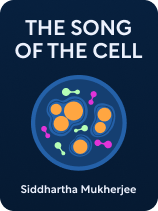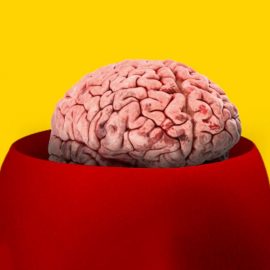

This article is an excerpt from the Shortform book guide to "The Song of the Cell" by Siddhartha Mukherjee. Shortform has the world's best summaries and analyses of books you should be reading.
Like this article? Sign up for a free trial here.
What’s The Song of the Cell by Siddhartha Mukherjee about? How can cell biology change the way we think about the human body?
Siddhartha Mukherjee’s The Song of the Cell: An Exploration of Medicine and the New Human dives into cell biology—examining its history, its use in modern medicine, and its radical possibilities for the future. Mukherjee considers the all-encompassing role cells play in our understanding of illness and the body.
Read more in our overview of The Song of the Cell: An Exploration of Medicine and the New Human.
Overview of The Song of the Cell
In his book The Song of the Cell, Siddhartha Mukherjee explores cell biology: its history as a field of study, how it transformed medicine, and new practices that could help to eliminate cancer and other diseases. He also considers the prospect of cellular or genetic engineering, both in the treatment of illnesses and the possibility of creating “new humans” for whom hereditary diseases are a thing of the past. The book builds on his previous works on the history of cancer and DNA to explain the science of cells to the lay reader.
An Indian-American who completed his education at Stanford, Harvard, and Oxford, Mukherjee is a professor of medicine at New York’s Columbia University. In addition to publishing his research in medical journals, he frequently writes for publications such as The New Yorker, The New York Times, and Vice about cellular therapy, genetics, the Covid-19 pandemic, the medical uses of artificial intelligence, and the emotional turmoil physicians face. His most acclaimed book, The Emperor of All Maladies, won the 2011 Pulitzer Prize, and much of that book’s subject matter is revisited in The Song of the Cell.
This overview of The Song of the Cell: An Exploration of Medicine and the New Human is structured around the five major tenets of cell biology that Mukherjee discusses. These tenets define where cells come from, how cells are related to each other, and how biologists must think about cells when treating disease—not as isolated, self-sustaining “blocks” but as part of a larger, complex system.
The five tenets are:
- All cells come from other cells.
- All cells are fundamentally similar, even though they can also be profoundly different in form and function.
- Cells work together in complex systems to perform bodily functions that they can’t do individually.
- Disease and death result from a breakdown of the relationships between cells or from an imbalance in the processes of cell decay, repair, and rejuvenation.
- Cells and our scientific knowledge about them will play a vital role in the future of medicine.
We’ve split these tenets into two groups: Understanding Cell Biology discusses tenets 1 and 2, which deal mostly with the basic nature and function of cells within the body. Cell Pathology in Medicine discusses tenets 3, 4, and 5, which deal with how cells work together, how the breakdown of those relationships leads to disease and death, and how cells can be used to fight disease. We’ll also examine how cells were discovered, modern understandings of their function, the different types of cells in the body, and the use of cellular manipulation or engineering to treat disease.
Understanding Cell Biology
Mukherjee begins with an overview of cell biology, including the history of the field since the 19th century, the general characteristics of human cells, and cellular processes like energy production and reproduction through cellular division.
Tenet 1: All Cells Come From Other Cells
Mukherjee argues that the discovery of cells revolutionized medicine, complicating previous theories of disease that attributed bodily illness to an imbalance of fluids like blood and phlegm, poor air quality, or mental health issues. The discovery that cells, like all living beings, are born from a parent of the same type also complicated popular understandings of reproduction.
What Are Cells?
Mukherjee defines cells as the autonomous, self-regulating “units” that make up all living things. Cells were first named in 1837, and their discovery established that all organisms—plants, animals, insects, even bacteria—are fundamentally alike in their basic makeup. This discovery also revealed that the human body is less a single life than an “ecosystem” that supports many different lives, all working together to keep the whole functioning.
Today, says Mukherjee, it’s generally accepted that there are four major branches of cellular life—bacteria, prokaryotes, archaea (all single-celled); and eukaryotes (multicellular organisms such as humans, other animals, plants, and fungi). Eukaryotic cells are the most complex, and the only branch to contain nuclei, which store DNA (double-stranded deoxyribonucleic acid) in the form of chromosomes. They are also the “youngest” type of cell, having evolved only two billion years ago, while the first single-celled organisms likely appeared four billion years ago.
Where Do Cells Come From?
Although cells had been observed before, , a unified theory only emerged in 1839: that cells are the “building blocks” of all forms of life. This theory was controversial, as it contradicted popular religious sensibilities and related scientific theories like vitalism (the belief that life came from a “divine spark” bestowed by God and could not be reduced to chemical processes). Even when cellular theory became more widely accepted, cells’ origins were debated—did they come into existence spontaneously, from a divine spark, or did they reproduce as larger organisms did?
In the 1850s, the process through which all cells are formed, cellular division, was discovered: one parent cell reproduces by splitting and forming two daughter cells. There is no spontaneous generation of life; all cells are related, dating back to the first single-celled organism from which all life on Earth must have originated. Mukherjee argues that this discovery—that all cells arise from other cells—is essential to our understanding of human reproduction and the immune system. Likewise, mutations or unusual activity during this cellular reproductive process are partially responsible for everything from evolution to cancer.
How Does Cellular Reproduction Work?
Mukherjee describes two types of cellular reproduction: mitosis, in which a cell divides into two exact copies of itself, each containing the same number of chromosomes (clusters of genetic information in the form of DNA), and meiosis, in which a cell divides into two “gametes” (in the case of humans, either two sperm cells or two egg cells), each having only half the chromosomes of the original parent. These gametes will combine with the gamete of another organism to form the fertilized egg cell or zygote. This zygote ultimately develops into a new organism—such as a human fetus—by repeatedly undergoing mitosis.
Mukherjee says mitosis is merely production, the creation of new cells, while meiosis is true reproduction, leading to the creation of a new organism. While mitosis creates genetically identical copies of the parent, meiosis produces a new being from combined genetic information. Mutation can occur at any stage of either process, though cells conduct several “checks” to ensure the fidelity of the genetic information being copied. Mutations can be harmful, leading to disease or the failure of the resulting organism to properly develop, but they are also a part of the evolutionary process, leading to changes in the species over time.
Tenet 2: All Cells Are Fundamentally Similar
Mukherjee emphasizes that because all cells are related, and all cells in the body derive from a single zygote, all cells are fundamentally similar in structure, though they’re capable of specializing and go on to perform various functions throughout the body.
Cell Similarities
Mukherjee states that all eukaryotic cells have the same key structures and organelles (mini-organs within cells) that give them their shape and allow them to carry out necessary self-sustaining functions. These functions include energy production, waste disposal, reproduction through division, and homeostasis—the maintenance of a cell’s internal environment and functionality, protecting it from disease or death. Any disruption to these processes can result in a breakdown of the body’s higher-level functions. Next, we’ll discuss cells’ key organelles and functions in more detail.
Nuclei and Proteins
Perhaps the most important characteristic of a eukaryotic cell is its nucleus, or “brain,” which contains most of the cell’s genetic information and uses that information to direct the production of proteins. Mukherjee says proteins are responsible for most of a cell’s activity, as they trigger the chemical processes that produce energy, direct the various stages of cellular reproduction, and bind to the cell’s membrane to allow other proteins or molecules to enter or exit.
Energy Production
The main organelle involved in a cell’s energy production is the mitochondria, a sort of mini-cell within a cell which contains its own genetic information. Mitochondria produce energy in the form of adenosine triphosphate (ATP) by breaking down glucose, or sugars. This energy is then used to carry out most other functions of the cell, keeping it alive. Mukherjee notes that cells that consume a great deal of energy—such as muscle, fat, or brain cells—typically contain multiple mitochondria.
Waste Disposal and Homeostasis
Several organelles are involved in removing or breaking down the cell’s waste products. They digest aging cell parts, inactive proteins, and bacteria and viruses that have entered the cell; maintain the cell’s internal acidity or alkalinity; and isolate chemical reactions whose products could be toxic to the rest of the cell. Mukherjee describes these processes as a combined function of homeostasis, in which the cell constantly works to maintain its equilibrium and overall health.
Cell Differences
A cell’s specialization into a particular type, such as a brain cell or skin cell, is determined by the cell’s DNA as interpreted by the nucleus. Certain portions of this DNA can be activated or deactivated to trigger the production of proteins and other chemicals needed for the cell to develop new structures (or, alternatively, to stop producing proteins or triggers responsible for the cell’s current activity). While most cell specialization occurs during the fetal development stage, what causes a cell to make these changes after gestation is not entirely clear, though Mukherjee suggests that it’s due to some environmental trigger—the cell detects a change or need elsewhere in the body.
Mukherjee discusses many types of cells, but he devotes particular attention to blood cells, which play a major role in the immune system, and bone cells, where most of the body’s adult stem cells can be found. These cell types are frequently the focus of his work as an oncologist and the subject of many recent theories for how cellular therapy can be used to eliminate disease and radically improve human health.
Blood Cells
Blood has three cellular components: red blood cells, platelets, and white blood cells, all of which are carried throughout the body by a fluid called plasma. Plasma is mostly water and contains various proteins, hormones, nutrients, clotting factors, and carbon dioxide. Of the three cellular types, red blood cells are responsible for carrying oxygen from the lungs to the rest of the body, platelets are responsible for clotting, and white blood cells detect disease and coordinate the body’s immune response.
1) Red Blood Cells: Red blood cells carry oxygen to the various tissues of the body and “deform” to squeeze through small blood vessels. Most of a red blood cell is made up of the protein hemoglobin, which contains iron and is therefore able to bind to oxygen. Mukherjee mentions that diseases like anemia and sickle cell anemia arise when the body fails to produce enough red blood cells or when the cells are malformed and carry less oxygen. Red blood cells also determine a person’s blood type—different proteins are present in red blood cells in different people, and when blood is transferred from one person into another, it may be recognized by the recipient’s immune system as foreign, triggering a violent or even fatal reaction.
2) Platelets: Platelets are tiny cell fragments responsible for blood clotting. They develop in the bone marrow (the soft tissue inside your bones) and circulate in the bloodstream, responding to signals from proteins that detect injuries in blood vessels to gather at the damaged site and clot. This prevents further blood loss.
Both underproduction and overproduction of platelets can lead to serious health problems, and even platelets’ normal functions are linked to heart attacks—for instance, if a blood vessel becomes obstructed by cholesterol-rich plaque which then ruptures, the body interprets this as a wound and sends platelets to clot the area, restricting blood flow to and from the heart. Mukherjee notes various factors with potential risks for plaque formation, including diabetes, hypertension, fat-rich diets, and smoking.
3) White Blood Cells: White blood cells, or leukocytes, are responsible for coordinating the body’s immune response, fighting off disease or infection by consuming and destroying antigens (a molecule or substance that triggers an immune response), dead cells, and tumor cells. Phagocytic cells ingest antigens and break them down into their harmless chemical components, while lymphocytes recognize and target specific antigens. Mukherjee describes lymphocytes as the “adaptable immune system,” responding to a unique antigen with a unique immune response, versus the one-size-fits-all behavior of phagocytic cells. While phagocytic cells can act more quickly, they may fail to destroy stronger antigens.
Mukherjee explains that there are two types of lymphocytes; B cells and T cells. B cells produce antibodies—proteins designed to bind with and neutralize specific antigens. Each B cell is capable of producing only one type of antigen, and the correct B cell is only activated once it “recognizes” an antigen by bonding with it. B cells remain in the blood even after the antigen has been eliminated, enabling a faster immune response if you’re exposed again. This is the main principle behind vaccines—by introducing your body to an antigen in a small, controlled amount, the relevant B cells are activated and are prepared to respond to a later, more serious infection.
Mukherjee says that antibodies can’t enter cells, so T cells alone are responsible for detecting and destroying cells that have been infected or become cancerous. He stresses that the T cell’s most important function is to recognize cells that belong to the shared body of the organism versus those that are foreign. It does this through a combination of recognizing the cells’ genes (the “self”) and recognizing proteins that are produced only by a virus or an infected cell (the “nonself”). Having recognized an invader, T cells will attack the infected cell with toxic chemicals until it dies. However, this ability of T cells to recognize foreign materials also makes them responsible for complications in medical transplants of skin, bones, and organs.
Bone Cells
Bone cells are distinguished by their ability to gain size or change shape, allowing the skeleton to grow, heal from a fracture, or dissolve pieces that aren’t functioning properly. Mukherjee also highlights cartilage cells, which connect bones together, osteoblasts that deposit calcium to thicken or extend an existing bone, and osteoclasts, which degrade existing bone that’s become too thick or is restricting bone marrow. Several diseases are associated with the activity of these cells, such as osteoarthritis (underproduction and loss of existing cartilage) or osteoporosis (resulting from overactive osteoclasts, especially later in life when the body is no longer producing much new bone).
Stem Cells: For Mukherjee, the most significant characteristic of bones is their high quantity of adult stem cells. Found in bone marrow, stem, or “undifferentiated,” cells are capable of evolving into any other cell type—blood cells, muscle cells, skin cells, and so on—and in fact are the original cell from which every other cell in the body develops during pregnancy. Embryonic stem cells produce all the needed organs and tissues as a zygote grows into an embryo and then a fetus, while adult stem cells are responsible for growth, repairing the body, and the production of blood cells. Each stem cell is capable of producing billions of daughter cells, including identical copies of itself and mature cells of other types.
Mukherjee describes how bone marrow transplants have been used to treat cancers like leukemia, allowing recipients to produce new, healthy blood cells. Within the bone itself, skeletal stem cells, or OCHRE (osteo, chondro, and reticular) cells, can differentiate into cartilage cells and osteoblasts, creating new bones or lengthening existing ones. These stem cells are most active in children and adolescents, and their populations shrink over time, slowing or stopping the growth of the skeleton in adults. With the loss of stem cells, it becomes more difficult for the body to maintain bone thickness or repair bone in the event of a fracture or break.
Cell Pathology in Medicine
Moving beyond his descriptions of cells, Mukherjee considers how new practices like cellular therapy and cellular engineering can advance medicine. He’s particularly interested in the prospect of manipulating cells to cure cancer, eliminate disease, and even alter the human genome—though he acknowledges how little is still known, the potential to do harm, and the ethical considerations. Above all, he emphasizes that nothing in the body works in isolation. Cells are constantly communicating with one another, and while this enables many of the body’s most complex and impressive functions, it also means that any disruption to the system could have unexpected consequences.
Tenet 3: Cells Work Together in Complex Systems
Mukherjee refers back to 19th-century descriptions of cells as a kind of community, able to function independently but constantly working in tandem to reproduce, exchange chemicals and proteins, and enable the body’s more complex processes. Cells work together not only within an organ or system, but across the body as a whole. For example, the circulation of blood involves not just blood cells but those of the heart, the lungs, the bones, the pancreas , and the kidneys . Understanding health and homeostasis requires a global view of cells.
Mukherjee stresses that just as the body’s normal, healthy functions are complex and diffuse, so is the breakdown of those functions in the form of injury or disease. Though he believes that all illness has a cellular cause, he says that identifying that cause is often difficult, as a patient can display many unusual cellular behaviors without a clear cause or effect. For example, a patient may have a low T cell count due to an infection of the bone marrow, or the bone marrow infection may be a result of a low T cell count failing to fight the disease. Therefore, understanding illness and dysfunction requires a holistic approach.
Tenet 4: Disease and Death Result From a Breakdown of Cell Relationships and Activity
According to Mukherjee, cellular biology is closely related to germ theory, the now-dominant belief in medicine that disease occurs on a microscopic level with cells being invaded and made dysfunctional by foreign agents. Having entered a cell, bacteria may produce toxins that kill the cell outright, impair or destroy the organelles responsible for energy production, and consume needed proteins and chemicals. Likewise, viruses can “hijack” the cell nucleus to produce many copies of themselves and viral proteins, spreading the infection further. Altogether, Mukherjee argues that disease can be understood as a disruption in cellular activity, whether this means the cessation of activity, impaired activity, or overactivity.
How Cancer Cells Work
As an oncologist, Mukherjee is particularly interested in cancer cells, which are distinguished by their relentless growth. A cancer cell is unable to properly interpret the signals that start and stop cell reproduction, thus dividing endlessly and mutating along the way, sometimes forming a mass called a tumor. Because cancer cells are not foreign material and do not produce proteins that indicate the presence of disease, they can go unrecognized by the immune system. In a sense, Mukherjee suggests, cancer cells are not impaired so much as they perform their function too well, damaging and potentially killing their organism.
Imbalance in Cell Activity
Mukherjee notes that illness or death can also be caused by an imbalance between the activity of two types of cells. Sometimes, the cells that work to destroy or remove tissue are simply working faster than the cells that work to create or repair it. This is the cause of degenerative illness like osteoporosis (loss of bone mass) and Alzheimer’s (loss of brain cells). It’s also the case with radiation sickness—though many of a patient’s blood cells may die as a result of radiation exposure, death occurs most often because damaged bone marrow is unable to produce new, healthy blood cells. Even death from old age, Mukherjee states, is ultimately the result of the natural processes of decay outpacing those of rejuvenation.
Tenet 5: Cells Will Play a Role in the Future of Medicine
Mukherjee describes four major types of cellular therapy that arose out of cell biology, including some that are already an accepted part of medicine—such as antibiotics, blood transfusions, and vaccines—and others that are still experimental but may play a role in treating or eliminating cancer. These include altering the properties of cells using drugs, chemicals, or physical stimulation; transferring cells between two bodies, or extracting cells from a person and then reimplanting them; using cells in a laboratory setting to synthesize a useful substance, like insulin; and genetically modifying cells to give them—or the larger organ or organism—new properties.
Genetic Engineering to Fight Disease
When the cells in a person’s body are not behaving properly—for example, if their bone marrow is unable to produce healthy blood cells—a transfer of healthy cells from another person can treat the disease, though this requires finding a close enough match. As an alternative, Mukherjee describes how cellular engineering could allow cells from a patient’s body to be extracted, genetically modified, and reimplanted so that they can function properly again. In another approach, healthy cells could be grown from scratch in a lab, or cells could be altered without removal.
Diabetes
Diabetes is caused by a dysfunction of the pancreas in which it’s either unable to produce sufficient insulin (type 1) or is no longer producing as much insulin as it used to (type 2). Insulin is needed for the body to break down and absorb energy from sugars in food, and current treatments often require the patient to inject insulin into their bloodstream at least once a day. Mukherjee suggests that a more dramatic treatment, or even a cure, could come in the form of growing healthy pancreatic cells in a lab and implanting them into the patient. While some of these cells have been successfully grown from stem cells, implantation is still being tested.
Cancer
Modifying the patient’s cells is the basic principle behind T cell therapy, which trains the patient’s immune system to recognize and attack cancer cells. T cells are extracted or grown in a lab and then genetically modified to recognize proteins unique to the otherwise normal-appearing cancer cells. Mukherjee states that T cell therapy has been somewhat successful in treating leukemia, as in the famous case of Emily Whitehead, the first person to undergo this type of treatment at the Children’s Hospital of Philadelphia. But it can also backfire, causing an immune response so violent it kills the patient—Whitehead herself had to be hospitalized for severe inflammation while receiving treatment.
Mukherjee writes that another difficulty comes in finding a unique aspect of cancer cells that T cells can target. Unlike bacteria or viruses, cancer cells generally produce the same proteins as healthy cells, but direct them toward unhealthy growth. There is no foreign agent for the T cell to detect, and training a T cell to attack cells that are of its own body may lead to it to view the entire body as foreign, giving the patient an autoimmune disease. Cancer cells also mutate over time, meaning that they may effectively evolve out of the characteristic that made them vulnerable to T cell therapy.
Modifying Non-Human Cells
In addition to treatments using the patient’s own cells, foreign or infectious cells can also be used to fight disease. Mukherjee describes a treatment for Leber hereditary optic neuropathy (LHON), a condition that causes vision loss, which involves genetically modifying a virus and injecting it into the patient’s eye. The virus takes over the patient’s mutated cells and rewrites their mitochondria to make them behave normally. While this treatment is still being tested and is only effective for patients in the early stages of the disease, Mukherjee says it has many upsides—namely that the virus infects the patient without causing acute disease and is injected in such small amounts that it’s unlikely to trigger an immune response.
Genetic Engineering to Prevent Disease
All of the cellular therapies Mukherjee has described so far involve modifying cells’ genes to treat disease in an existing person. The more controversial options involve editing cells and DNA in the womb, or in the lab prior to IVF implantation, to create a new kind of human: one resistant to disease, without any unwanted mutations, and potentially longer-lived than humans today. While Mukherjee is excited about the possibility of eliminating disease, he expresses caution toward the idea of the genetically engineered human, noting that interfering with DNA could have unexpected consequences and that the idea of genetically “improving” people is inextricably tied to racism and eugenics.
IVF
Mukherjee notes that in vitro fertilization (IVF) was an extremely controversial practice when it was first introduced in the late 1970s, with critics expressing anxiety about the “artificiality” of fertilization taking place in a lab and the fact that some zygotes are destroyed in the process of creating a viable embryo. What remains controversial is the prospect of using IVF to genetically modify embryos before implantation. Currently, doctors can screen embryos to identify the sex and the presence of hereditary mutations that could lead to Down syndrome, muscular dystrophy, and cystic fibrosis. While these embryos are not modified in any way, the parents can choose not to implant them based on this information.
Gene Editing
Scientists have long considered the possibility of gene “editing,” in which undesirable mutations are excised or new mutations are introduced as a way to produce a healthy organism or one with specific characteristics. Mukherjee notes that this practice has been carried out on mice, sheep, and cows to make them more resistant to disease or to carry proteins in their milk or their meat that are good for humans. However, he warns that DNA is so complex that even a minor change may damage the whole in unexpected ways.
Mukherjee provides a real-world example of the dangers—both medical and ethical—of gene editing in the case of He Jiankui, who in 2017 claimed to have genetically modified two female twins in China to prevent the transmission of HIV from their father. He attempted to recreate the natural genetic mutation “delta 32,” which gives some people resistance to HIV. Critics argued that he failed to properly inform the parents of the risks, as his edits (which were not identical to the delta 32 mutation) may have permanently damaged the twins’ immune systems. Also, the children were never in danger in the first place, because the IVF process “washes” sperm cells of HIV before fertilization, making transmission impossible.
He Jiankui’s actions were widely condemned, and he was ultimately sentenced to three years in prison. However, Mukherjee notes that other biologists are pursuing similar experiments, such as the Russian biologist Denis Rebrikov, who proposes modifying DNA to prevent deaf adults from having deaf children. Some medical authorities have proposed establishing a ban on gene editing, but they lack the power to enforce it, while others argue that humanity has a responsibility to use science to reduce suffering, even if the definition of what qualifies as “suffering” remains unclear. Mukherjee does not come down firmly on either side, though he believes the adoption of gene editing into medical practice may be inevitable.

———End of Preview———
Like what you just read? Read the rest of the world's best book summary and analysis of Siddhartha Mukherjee's "The Song of the Cell" at Shortform.
Here's what you'll find in our full The Song of the Cell summary:
- A deep dive into cell biology—including its history, uses, and future possibilities
- How cells can be manipulated to cure cancer, eliminate disease, and alter genomes
- The moral and ethical implications of taking cell manipulation too far






